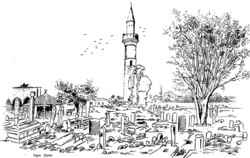Yeni Jami, Nicosia
Constructed of yellow sandstone, the residential houses have arched entrances, inner courtyards where there is usually a kitchen garden, fruit trees and a freshwater reservouar.
Unfortunately the recent years have seen the demolishing of quite a number of these buildings within the historic walls, after becoming a danger of collapse, due to lack of maintenance and or neglect.
About in the centre of the cemetery stands a block of ruins consisting of the south-west angle of the medieval church of which the turret staircase has been carried up as the minaret of the mosque, hence the preservation of the fragment.
In 1740 this Mosque was destroyed by a rapacious Pasha (Menteszade Haci Ismail Agha), who dreamt that a hidden treasure was to be found underneath it.
[14] Yeni Jami has a simple entrance hall formed of four Gothic arches, which also runs along the right side of the building as an open corridor; in front of it is a covered spring.
[14] The original building was a Latin church, built in the fourteenth century, which was converted to a mosque in 1571, immediately after the Turkish conquest.
